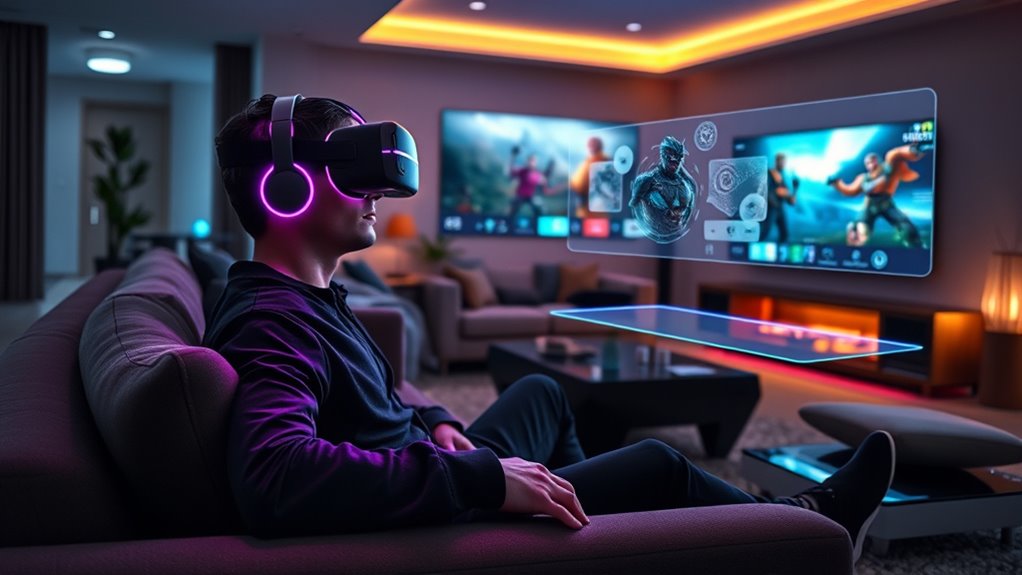VR and AR are changing how you enjoy home entertainment. VR immerses you in completely new worlds, letting you explore, play games, or experience stories as if you’re really there. AR adds digital elements to your real environment, like trying virtual furniture or playing interactive games through your device. These technologies make entertainment more interactive and social, connecting you with friends and new experiences right from home. If you’re curious about how they work, there’s plenty more to discover before you start exploring.
Key Takeaways
- VR creates immersive, interactive virtual environments that enhance gaming and entertainment experiences at home.
- AR overlays digital elements onto real-world spaces, enabling virtual try-ons and interactive activities.
- Both technologies allow social interaction with friends through shared virtual worlds and collaborative experiences.
- VR and AR expand home entertainment beyond screens, offering interactive storytelling, puzzles, and educational content.
- Advancements and affordability are making VR and AR more accessible, enriching personal entertainment options.

Virtual reality (VR) and augmented reality (AR) are transforming home entertainment by immersing you in new worlds and enhancing everyday experiences. These technologies bring a level of engagement that traditional screens simply can’t match, allowing you to step into the action and feel truly present. With VR, you can explore distant landscapes, participate in interactive gameplay, or attend virtual concerts—all from the comfort of your living room. AR, on the other hand, overlays digital elements onto your real-world environment, making everyday activities more engaging and interactive.
When you use VR headsets, you’re transported into fully immersive experiences that respond to your movements. This means that your actions directly influence what you see and do within the virtual environment. Whether you’re *exploring* a fantasy *domain*, solving puzzles, or competing with friends in multiplayer games, VR offers a sense of presence that heightens the thrill of gameplay. The level of interactivity is impressive, as you can reach out, grab objects, or dodge obstacles, creating a seamless, engaging experience. This interactivity makes gaming sessions more dynamic and personal, drawing you deeper into the story or challenge.
AR enhances home entertainment by blending digital content with your physical surroundings. Using smartphones or AR glasses, you can add virtual objects to your real-world space—like placing furniture in your living room or trying out new hairstyles virtually. Many AR applications also offer interactive experiences, such as playing games that involve real-world movements or exploring educational content that overlays information onto physical objects. This technology makes everyday activities more enjoyable and engaging, encouraging you to interact with your environment in new ways.
Both VR and AR are expanding the possibilities for social interaction at home. With VR, you can join friends in virtual worlds, attending parties or collaborative missions regardless of where you are physically located. AR-enabled apps allow you to share experiences, like collaborative design projects or multiplayer games, that involve interactive gameplay elements. These innovations foster a sense of community and shared adventure, making entertainment more social and connected.
As these technologies become more accessible and affordable, they’re shaping the future of home entertainment. Whether you’re seeking immersive experiences that transport you to distant worlds or engaging interactive gameplay that challenges and entertains, VR and AR are revolutionizing how you enjoy your leisure time. They’re not just tools for gaming—they’re gateways to new ways of experiencing and interacting with the world right from your living space. Additionally, advancements in projector technology are making it easier to create stunning visual environments that complement VR and AR experiences, further enriching home entertainment options.
Frequently Asked Questions
How Do VR and AR Differ in Home Entertainment Applications?
VR creates virtual immersion, placing you fully into a digital world with headsets that block out your surroundings. AR, on the other hand, adds augmented overlays to your real environment, enhancing it with digital elements through devices like smartphones or smart glasses. You experience VR as a completely separate space, while AR enhances your existing environment, making each suited for different home entertainment experiences.
What Hardware Is Required for a VR or AR Setup?
To establish VR or AR at home, you’ll need a VR headset or AR glasses. A VR headset, like Oculus Quest or HTC Vive, provides immersive experiences, so guarantee your device is compatible with your computer or console. For AR, AR glasses such as Microsoft HoloLens or Magic Leap are essential. Additionally, a powerful enough CPU, GPU, and sufficient space help optimize your experience and ensure smooth gameplay.
ARe VR and AR Experiences Suitable for All Age Groups?
VR and AR experiences aren’t suitable for all age groups, especially young children, due to safety concerns. You should prioritize child safety by supervising usage and choosing experiences with accessible features designed for kids. For older users, check for adjustable settings to enhance comfort and accessibility. Always verify proper hardware fit and limit session times to prevent discomfort or health issues.
What ARe the Costs Associated With Integrating VR and AR at Home?
The costs associated with integrating VR and AR at home include several factors you should consider. Your cost considerations involve purchasing hardware like headsets and sensors, along with software subscriptions or apps. Installation expenses can also add up if you need extra space or professional help setting up. Budgeting for these upfront costs guarantees you’re prepared to enjoy immersive entertainment without surprises. Remember, prices vary based on device quality and features.
How Do VR and AR Impact Traditional Gaming and Media Consumption?
VR and AR revolutionize traditional gaming and media, transforming your living room into a portal to new worlds. You can immerse yourself in virtual socializing, connecting with friends in immersive environments, or experience interactive storytelling that puts you at the heart of the action. These technologies turn passive viewing into active participation, making entertainment more engaging and personalized, much like stepping into your favorite movie or game.
Conclusion
As you explore VR and AR at home, you might wonder if these technologies will truly revolutionize entertainment. While some say they’re just a passing fad, recent advances suggest otherwise—these immersive experiences are becoming more accessible and realistic every day. So, don’t dismiss the idea that, in the near future, your living room could transform into a whole new world. The truth is, VR and AR are shaping the future of home entertainment, and you won’t want to miss out.















